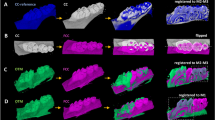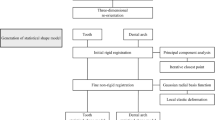Abstract
In this study, we propose an integrated tooth segmentation and gingival tissue deformation simulation framework used to design and evaluate the orthodontic treatment plan especially with invisible aligners. Firstly, the bio-characteristics information of the digital impression is analyzed quantitatively and demonstrated visually. With the derived information, the transitional regions of tooth-tooth and tooth-gingiva are extracted as the solution domain of the segmentation boundaries. Then, a boundary detection approach is proposed, which is used for the tooth segmentation and region division of the digital impression. After tooth segmentation, we propose the deformation simulation framework driven by energy function based on the biological deformation properties of gingival tissues. The correctness and availability of the proposed segmentation and gingival tissue deformation simulation framework are demonstrated with typical cases and qualitative analysis. Experimental results show that segmentation boundaries calculated by the proposed method are accurate, and local details of the digital impression under study are preserved well during deformation simulation. Qualitative analysis results of the gingival tissues’ surface area and volume variations indicate that the proposed gingival tissue deformation simulation framework is consistent with the clinical gingival tissue deformation characteristics, and it can be used to predict the rationality of the treatment plan from both visual inspection and numerical simulation. The proposed tooth segmentation and gingival tissue deformation simulation framework is shown to be effective and has good practicability, but accurate quantitative analysis based on clinical results is still an open problem in this study. Combined with tooth rearrangement steps, it can be used to design the orthodontic treatment plan, and to output the data for production of invisible aligners.

Graphical abstract













Similar content being viewed by others
References
Proffit, William R., et al. Contemporary orthodontics. Elsevier Health Sciences, 2018
Pacheco-Pereira C, Brandelli J, Flores-Mir C (2018) Patient satisfaction and quality of life changes after Invisalign treatment. Am J Orthod Dentofac Orthop 153(6):834–841
Cunningham SJ, Hunt NP (2001) Quality of life and its importance in orthodontics. J Orthod 28(2):152–158
Graber LW, Vanarsdall RL, Vig KWL et al (2016) Orthodontics: current principles and techniques. Elsevier Health Sciences
Logozzo S, Zanetti EM, Franceschini G, Kilpelä A, Mäkynen A (2014) Recent advances in dental optics–Part I: 3D intraoral scanners for restorative dentistry. Opt Lasers Eng 54:203–221
3D Scanners, Digitizers, and Software for making 3D Models and 3D Measurements. http://www.simple3d.com/
Sun LJ, Lee JS, Choo HH, Hwang HS, Lee KM (2018) Reproducibility of an intraoral scanner: a comparison between in-vivo and ex-vivo scans. Am J Orthod Dentofac Orthop 154(2):305–310
Fleming PS, Marinho V, Johal A (2011) Orthodontic measurements on digital study models compared with plaster models: a systematic review. Orthod Craniofacial Res 14(1):1–16
Rheude B, Lionel Sadowsky P, Ferriera A et al (2005) An evaluation of the use of digital study models in orthodontic diagnosis and treatment planning. The Angle Orthodontist 75(3):300–304
Cohen-Or D, Greif C, Sorkine-Hornung O et al (2015) A sampler of useful computational tools for applied geometry, computer graphics, and image processing. AK Peters/CRC Press
Yan Q, Dong H, Su J, Han J, Song B, Wei Q, Shi Y (2018) A review of 3D printing technology for medical applications. Engineering 4:729–742
Tarraf NE, Ali DM (2018) Present and the future of digital orthodontics. Seminars in Orthodontics WB Saunders 24(4):376–385
Nguyen T, Jackson T (2018) 3D technologies for precision in orthodontics. Seminars in Orthodontics WB Saunders 24(4):386–392
Joffe L (2004) Current products and practices OrthoCAD™: digital models for a digital era. J Orthod 31(4):344–347
Moles R (2009) The SureSmile system in orthodontic practice. Journal of clinical orthodontics: JCO 43(3):161–174
Westerlund A, Tancredi W, Ransjö M, Bresin A, Psonis S, Torgersson O (2015) Digital casts in orthodontics: a comparison of 4 software systems. Am J Orthod Dentofac Orthop 147(4):509–516
Kravitz ND, Kusnoto B, BeGole E, Obrez A, Agran B (2009) How well does Invisalign work? A prospective clinical study evaluating the efficacy of tooth movement with Invisalign. Am J Orthod Dentofac Orthop 135(1):27–35
Yuan T, Liao W, Dai N et al (2010) Single-tooth modeling for 3D dental model. J Biomed Imag 2010:9
Zou B, Liu S, Liao S, Ding X, Liang Y (2015) Interactive tooth partition of dental mesh base on tooth-target harmonic field. Comput Biol Med 56:132–144
Kronfeld T, Brunner D, Brunnett G (2010) Snake-based segmentation of teeth from virtual dental casts. Computer-Aided Design and Applications 7(2):221–233
Sulaiman S, Yee T S, Bade A. Effect of time complexities and variation of mass spring model parameters on surgical simulation. Malaysian Journal of Fundamental and Applied Sciences, 2013;9(4)
Duan Y, Huang W, Chang H, et al. Modeling and simulation of soft tissue deformation. International MICCAI Workshop on Computational and Clinical Challenges in Abdominal Imaging. Springer, Berlin, Heidelberg, 2013; 221–230
Katz S, Tal A. Hierarchical mesh decomposition using fuzzy clustering and cuts. ACM Transactions on Graphics (TOG). ACM, 2003; 22(3): 954–961
Lai YK, Hu SM, Martin RR, Rosin PL (2009) Rapid and effective segmentation of 3D models using random walks. Computer Aided Geometric Design 26(6):665–679
Schnabel R, Wahl R, Klein R. Efficient RANSAC for point-cloud shape detection. Computer graphics forum. Oxford, UK: Blackwell Publishing Ltd, 2007; 26(2): 214–226
Koschan A F. Perception-based 3D triangle mesh segmentation using fast marching watersheds.2003 IEEE Computer Society Conference on Computer Vision and Pattern Recognition, 2003. Proceedings. IEEE, 2003;2: II-II
Li Z, Wang H (2016) Interactive tooth separation from dental model using segmentation field. PLoS One 11(8):e0161159
Yuan T, Dai N, Hao G, et al. Bio-information based segmentation of 3D dental models.2008 2nd International Conference on Bioinformatics and Biomedical Engineering. IEEE, 2008;624–627
Kondo T, Ong SH, Foong KWC (2004) Tooth segmentation of dental study models using range images. IEEE Trans Med Imaging 23(3):350–362
Kronfeld T, Brunner D, Brunnett G (2010) Snake-based segmentation of teeth from virtual dental casts. Computer-Aided Design and Applications 7(2):221–233
Liu A, Tendick F, Cleary K, Kaufmann C (2003) A survey of surgical simulation: applications, technology, and education. Presence: Teleoperators & virtual environments 12(6):599–614
Sederberg TW, Parry SR (1986) Free-form deformation of solid geometric models. ACM SIGGRAPH computer graphics 20(4):151–160
Cani-Gascuel M, Desbrun M (1997) Animation of deformable models using implicit surfaces. IEEE Trans on Visual Computer Graph 3(1):39–50
Lim De S., Manivannan Y.J., M. and Srinivasan, M. a. physically realistic virtual surgery using the point-associated finite field (PAFF) approach. Presence Teleop Virt, 2006;15 (3): 294–308
Molinari E, Fato M, De Leo G et al (2005) Simulation of the biomechanical behavior of the skin in virtual surgical applications by finite element method. IEEE Trans Biomed Eng 52(9):1514–1521
Delp S, Loan J, Basdogan, Rosen C (1997) Surgical simulation: an emerging technology for training in emergency medicine. Presence Teleop Virt 6:147–159
Hieber SE, Koumoutsakos P (2008) A Lagrangian particle method for the simulation of linear and nonlinear elastic models of soft tissue. J Comput Phys 227(21):9195–9215
Belyaev AG, Pasko AA, Kunii TL (1998) Ridges and ravines on implicit surfaces. Proceedings. Computer Graphics International (Cat. No. 98EX149). IEEE:530–535
Rossl C, Kobbelt L, Seidel H P. Extraction of feature lines on triangulated surfaces using morphological operators. Proceedings of the AAAI Symposium on Smart Graphics. 2000;71–75
Meyer M, Desbrun M, Schröder P, et al. Discrete differential-geometry operators for triangulated 2-manifolds. Visualization and mathematics III. Springer, Berlin, Heidelberg, 2003;35–57
Lawonn K, Gasteiger R, Rössl C, Preim B (2014) Adaptive and robust curve smoothing on surface meshes. Comput Graph 40:22–35
Sorkine O, Cohen-Or D, Lipman Y, et al. Laplacian surface editing. Proceedings of the 2004 eurographics/ACM SIGGRAPH symposium on geometry processing. ACM, 2004;175–184
Kobbelt, L. Discrete fairing. In Proceedings of the seventh IMA conference on the mathematics of surfaces,1997,97: 101–131
Funding
This work was supported by the National Natural Science Foundation of China (grant number 51705183).
Author information
Authors and Affiliations
Corresponding author
Additional information
Publisher’s note
Springer Nature remains neutral with regard to jurisdictional claims in published maps and institutional affiliations.
Highlights
• The digital impression can be segmented effectively and accurately.
• Local details of the digital impression can be preserved well during the process of deformation simulation.
• Qualitative analysis results of the volume and surface area variations indicate that the proposed gingival tissue deformation simulation framework can be used to simulate the gingival tissue deformation behavior.
• The proposed simulation framework can be used to design an orthodontic treatment plan and predict its rationality from both visual inspection and numerical simulation.
• The output data corresponding to the intermediate step’s digital impression can be used to make a mother mold for the production of invisible aligners.
Appendix
Appendix
Orthodontic treatment plan for a typical case with severe malocclusion, the treatment process is divided into 60steps and wearing 1 week for one step. a Initial position state with attachments. b Final target position state with attachments. c Intermediate steps(0,16,24,35,44,60) of the upper jaw and its corresponding 3D printed mother mold. d Intermediate steps (0,16,24,35,44,60) of the lower jaw and its corresponding 3D printed mother mold. e Invisible aligner corresponding to the 60 steps of the upper jaw in c
Clinical treatment results after wearing about 60 steps of invisible aligners by using orthodontic treatment plan in Fig. 14
Rights and permissions
About this article
Cite this article
Yuan, T., Wang, Y., Hou, Z. et al. Tooth segmentation and gingival tissue deformation framework for 3D orthodontic treatment planning and evaluating. Med Biol Eng Comput 58, 2271–2290 (2020). https://doi.org/10.1007/s11517-020-02230-9
Received:
Accepted:
Published:
Issue Date:
DOI: https://doi.org/10.1007/s11517-020-02230-9







